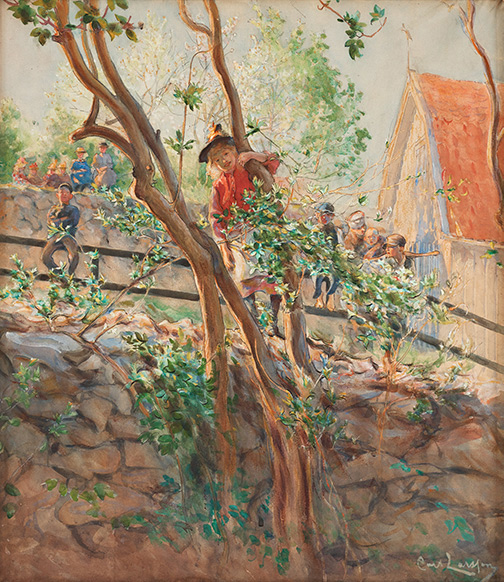Discover Carl Larsson's world at Important Spring Sale

Bukowskis can present no less than six fantastic works by Carl Larsson at Important Spring Sale. The catalogue will be published on Friday 21 May, auction 2 - 4 June
Carl Larsson Vet du vad? Var god och glad! / Esbjörn led / Grolle nicht
The piece depicts Carl and Karin Larsson’s two youngest children, Kersti and Esbjörn. They are standing in ‘Mutter på Tuppen’, the little cottage that he used as an etching studio, located next to the house on Blindgatan in Falun where Carl Larsson lived with his family when the children were at school. In the spring of 1907 the artist had had to leave their first term-time house in Falun. Georg Nordensvan writes how Larsson then “bought a nice little house with two stories on Blindgatan, gave its interior a completely new look, added a pleasant living room, at the same time salon and studio, and also bought an old dilapidated timber cottage on the neighbouring plot. It now experienced a reincarnation and became both neat and presentable. In later years that is where he had his bedchamber. The kitchen was furnished to become an inviting, real locus for etching” (Carl Larsson. II. 1890-1919, 1921).
The year before Larsson had portrayed the same interior in the watercolour Mitt etslokus, which was included in the widely distributed and much appreciated publication Åt solsidan, where Larsson also recounts to the reader the living situation in Falun: “…and now, my friends, it is idyllic, one room and a kitchen. The kitchen, here depicted, serves me as an etching workshop, and on these old, bare floor boards it does not much matter if once in a while I happen to spill a bottle of hydrochloric acid” (Åt solsidan. 31 målningar med text af Carl Larsson, third edition, Stockholm, 1915).
In the present auction’s watercolour Esbjörn, looking grumpy and a bit peevish, has reluctantly carried in more logs for the cottage, at his big sister’s behest. Ulwa Neergaard writes in Carl Larsson. Signerat med pensel och penna (1999), that “he doesn’t look like he wants to help out any more than that”. The watercolour, which was reproduced in the first issue of the then brand new art journal ‘Konst’ (15th November 1911), is characterised by the composition’s effect of depth as well as its subtle reproduction of the interior’s refined lighting.
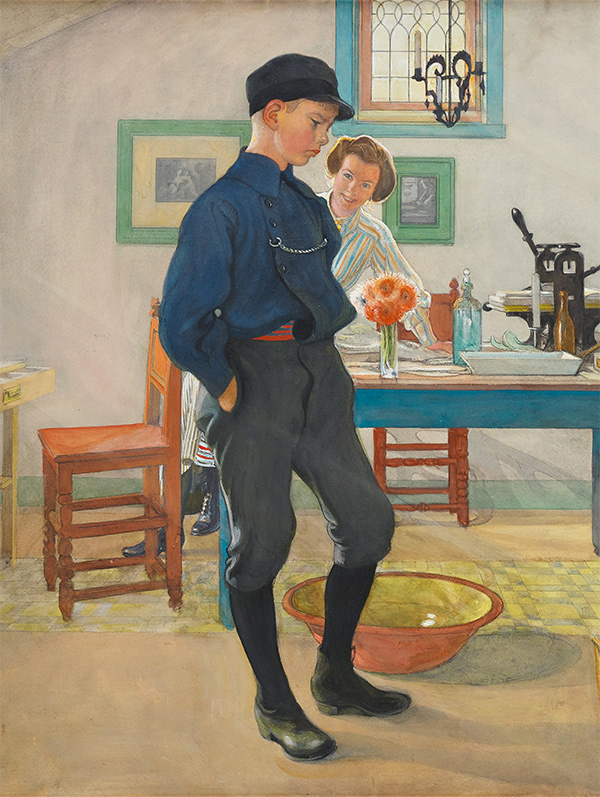
As regards to the watercolours executed at the start of the 1910s Georg Nordensvan specified that: “What is striking is the lively shades of colour in these watercolours of Hyttnäs, Spadarvet and the home in Falun. The colouring is light and airy or it is rich, saturated, and deeper in its tones than in the previous Sundborn-paintings with their thin colour and uniform look. The electric lighting plays a role in the interiors, in the play with light and shadow”.
The watercolour, which together with Anna S. / Syende flicka (watercolour, 66 x 99 cm, 1911, sold at a new world record hammer price at Bukowskis’ Important Winter Sale on 10th December 2020, Sparebankstiftelsen DNB, deposited at Lillehammer Kunstmuseum, Norway) and Dom spritar ärter / Ärtspritning (watercolour, 68 x 101 cm, 1912, private collection), holds a unique position in the artist’s work from this period and is also known under multiple titles. In his cashbook, the artist has noted it down with the title Grolle Nicht. According to Ulwa Neergaard, Carl Larsson also had the watercolour turned into a lithograph at A. Börtzells Tryckeri AB in Stockholm. These lithographs, which are said to measure 36 x 54 cm, were generally displayed within a white-painted frame, with a small metal plaque on its lower wooden section bearing the inscription: VET DU HVAD? VAR GOD OCH GLAD! (Do you know what? Be kind and happy!).
Carl Larsson Leontine, naken vid stranden
The model that contemplates her reflection in the clear water is most likely, one of Carl Larsson's favourite models, Leontina Lundström. In his memoirs "I" Carl Larsson writes the following about Leontina (whom he anonymised in the text under the name "Nina"):
"So number three, Nina, that is, for me she was number one, because of her I have painted most and best nude pictures."
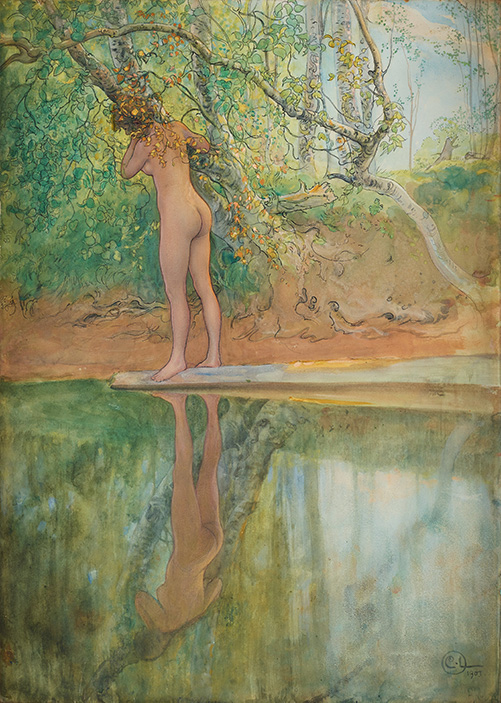
Carl Larsson Cherry Blossom / Woman in landscape
It was the sunlight and the open expanses that attracted a Swedish artist generation to Grez-sur-Loing. The realistic landscape painting practised in Grez-sur-Loing was characterized by a pale colour scheme often dominated by light ocher tones, grey, light blue and green. The Swedish landscape painters were appealed to by the hazy French air's ability to tune the colours of the landscape in a uniformly light tone where strong contrasts and contradictions were lacking.
In March 1884, Carl and Karin moved from Paris to the rural idyll of Grez-sur-Loing. Carl wrote in a letter to August Strindberg: "Now we live in Grèz, where I have rented a small house (studio, bedroom and dining room) for a whole year with the old woman Chevillon. Here is a glowing summer. We are very happy".
Grez played a vital role in Carl Larsson's artistic development. It was here that his painting underwent a transformation from academic studio painting in oil to outdoor realism in watercolour. Larsson was influenced by contemporary French outdoor painting, where the focus was on the harmony between man and nature and the play and refraction of light. Strong impressions also made the folklife motifs from the so-called "l'école rustique" where artists such as Millet and Bastien-Lepage were style creators. Larsson followed the example of his role models in the watercolours from Grez and painted simple motifs, the ones that were closest at hand: pumpkins in the kitchen garden, working farmers or children in the terrain.
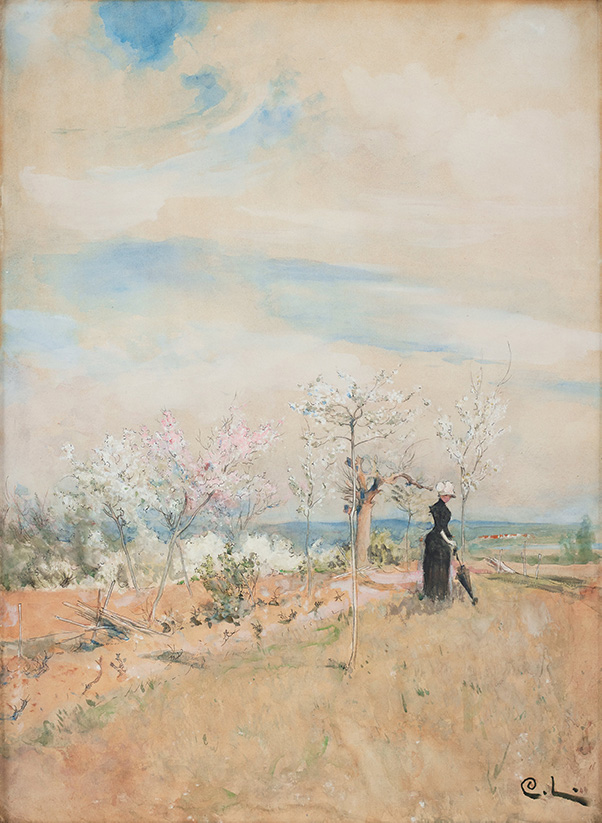
Carl Larsson Portrait of the Writer Carl G. Laurin
"When you think of Carl Laurin, you think of him most as an art lover and savvy. And you should do it with gratitude. For how empty was not the art scene in Sweden before Carl Laurin took care of the matter..."
The quote is taken from the artist Carl Larsson's article about the writer and art historian Carl G. Laurin in the newspaper IDUN, Sunday 7 January 1912.
The Laurin brothers came to play an important role in Carl Larsson's life as patrons and comrades, and the artist's gratitude and admiration shine through in this beautiful portrait where the model looks out over Stockholm from his imposing home on Bellmansgatan 6. The artist has depicted the model in profile in his writing room, subtly illuminated by daylight where he stands by one of the large windows.
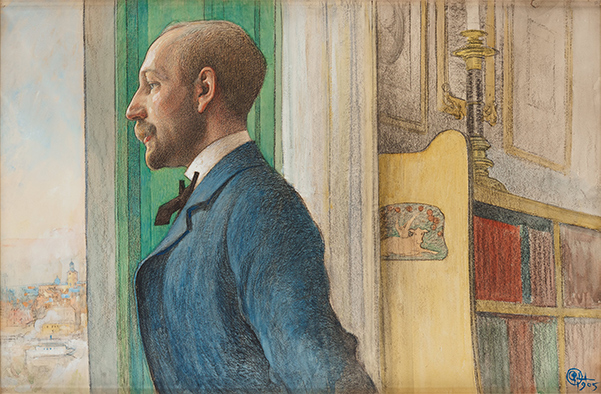
Carl Larsson Gunilla Laurin with her son Erik
The portrait depicts the writer and art historian Carl G. Laurin's wife Gunilla (born Petre) with her youngest son Erik in her lap. The models are depicted in the family's writing room in the impressive apartment at Bellmansgatan 6 in Stockholm. The address is surrounded by a certain shimmer as the property in question, "Mälarpalatset", is an almost indispensable element in Södermalm's district silhouette.
Carl Larsson was one of Carl Laurin's closest and dearest friends. With a real understanding for the family, the incomparable Swedish family painter portrayed the people dear to him".

Carl Larsson Parterre / Garden with children playing
In 1893, the Larsson family changed residence no less than four times. They lived in Gothenburg until Carl Larsson's leadership of Valand's drawing and painting school ended in April. The early summer was then spent in Marstrand, after which their address during the summer, in the usual way, was Sundborn in Dalarna. In the autumn, finally, the family moved to Stockholm to a studio apartment that Georg Pauli had just left to move to Gothenburg and take over responsibility for Valand's drawing and painting school after Carl Larsson.
The current watercolour was made in Marstrand, where Carl and Karin settled down temporarily, for a couple of months, in a fisherman's cottage, in the spring of 1893.
Stylistically, "Parterre" is reminiscent of the artist's watercolours from Grez, but the environment is Swedish. The finely tuned levelling haze that rests over the artist's French motifs from previous years has been replaced by a unique Nordic atmosphere that seeks to capture the Swedish summer atmosphere surrounding Marstrand. The air seems high and clear, and the colour and the drawing are intense where the sun shines over children, landscapes and houses. The watercolour's name, "Parterre", refers to the terrace where a group of children look out at something outside the picture. Perhaps their curious interest is captured by the fascinating sight of an outdoor painter at work?
